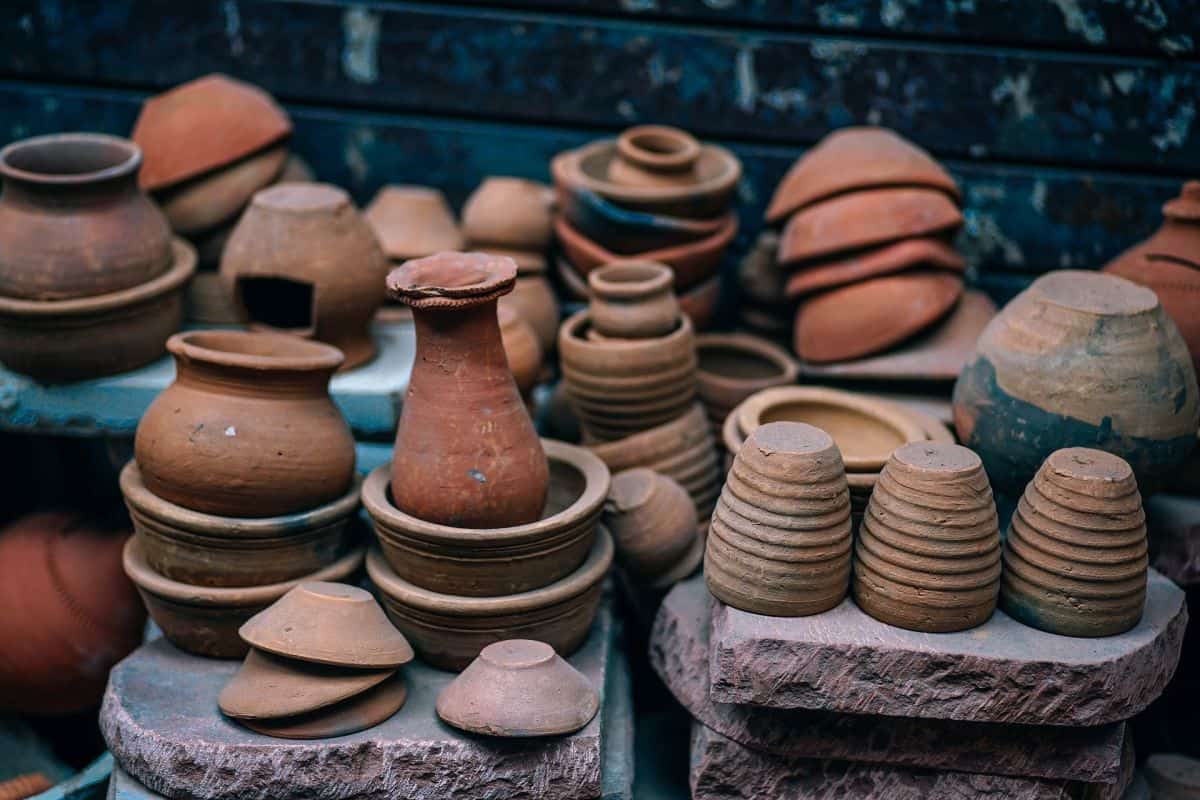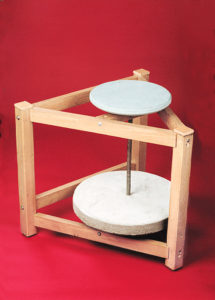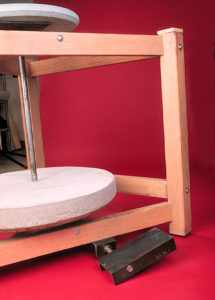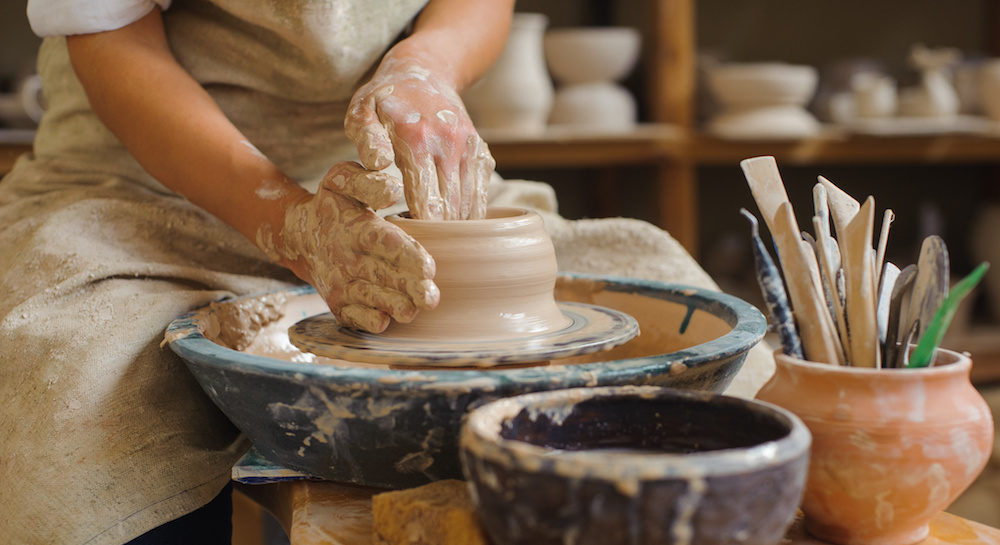
Pottery: The Ultimate Guide, History, Getting Started, Inspiration
Where did pottery get it's start? How can you get started with Pottery? This guide will give you an entertaining history of Pottery - the process of learning Pottery - and inspiration for both making pottery - and tasteful examples in decor.
Table Of Contents:
-
Introduction:
Why Pottery Matters
-
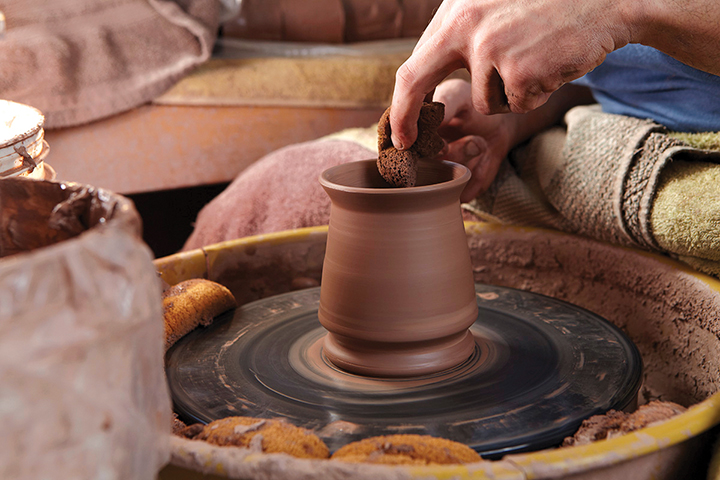
The History of Pottery
+ A Potter's Perspective
-
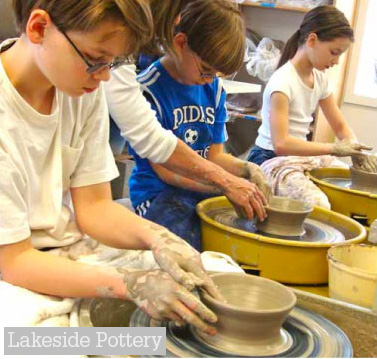
How to Get Started
Creating Pottery
-
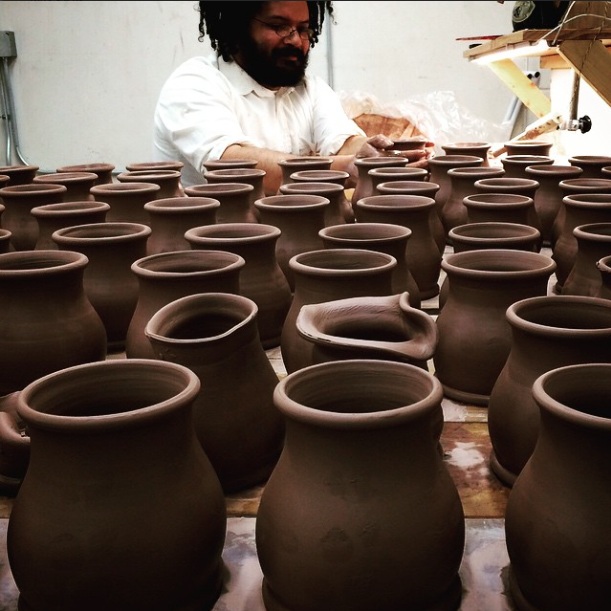
The Different Types
of Pottery
-
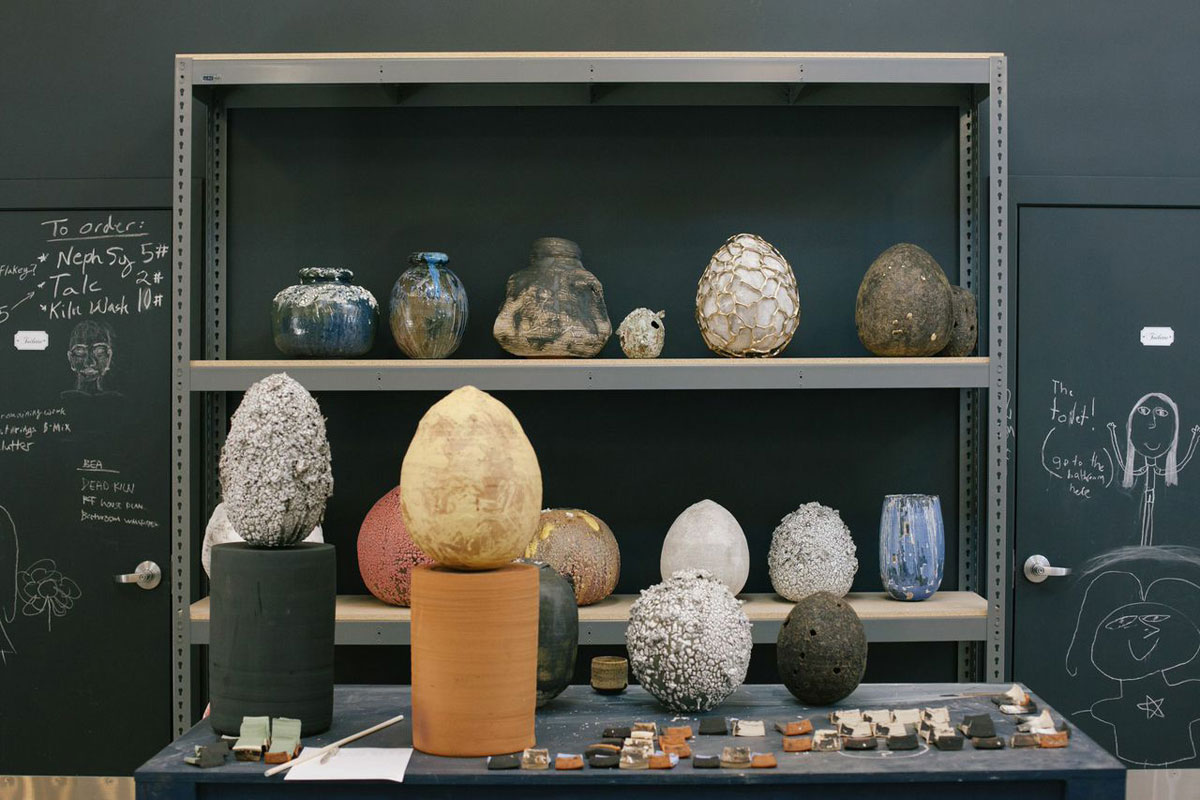
Pottery Inspiration
For Decor
-
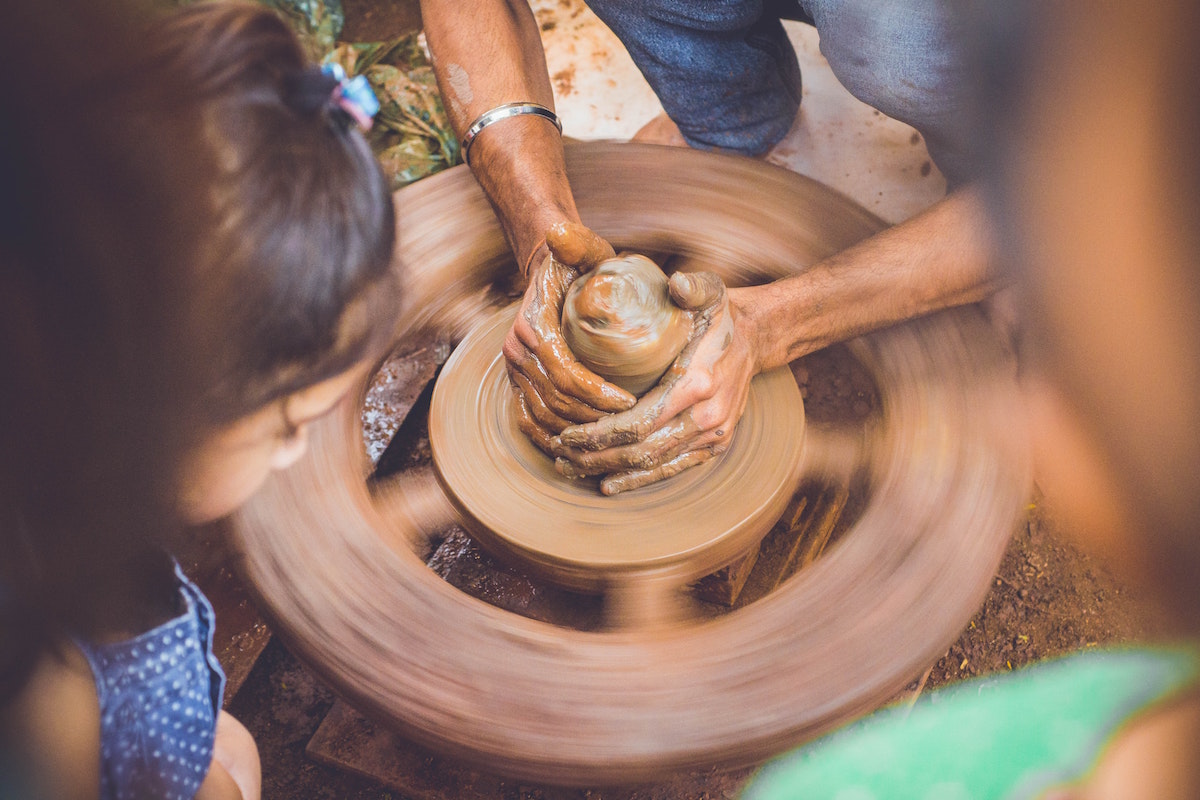
Pottery Inspiration
for Potters
Introduction:
Why Pottery Matters
As one of the oldest human inventions, pottery has been around since before the Neolithic period, with objects dating as far back to 29,000 BC. While in the past, the pottery industry has served marginal niches, today’s pottery companies are thriving thanks in part to a resurgence in consumer demand for unique, handmade goods over mass-produced items.
With such a bright outlook for the future, pottery is perhaps more popular than it has ever been. However, how pottery reached this point is a story filled with rich history.
Sometime between 6,000 and 4,000 BC, the first potter’s wheel was invented in Mesopotamia. This brought about a revolution in the way ancient people could create items out of clay. No longer were pottery makers restricted to the long process of hand molding clay — they were then able to have more freedom in experimenting with new forms and aesthetics.
While pottery had always had intrinsic artistic qualities, when the potter’s wheel arrived, it shifted the process even more. Instead of serving utilitarian purposes, it now served artistic ones. While the earliest types of items found by archaeologists were generally undecorated, unglazed, hand-formed clay vessels, by 6000 BC, places like the Middle East, China and Europe had developed a wide array of design techniques.
From intricate painted designs that told the history of a Pharaoh’s reign to highly polished bowls and plates to elaborate animal figures, ceramists attained remarkable skill and ability that was never seen before, thanks to the invention of the potter’s wheel.
If you want to know more about this unique, ancient practice and how it has evolved into the industry it is today, we’ve developed this guide for you. So, let’s get started – here’s the ultimate guide to the history of pottery!
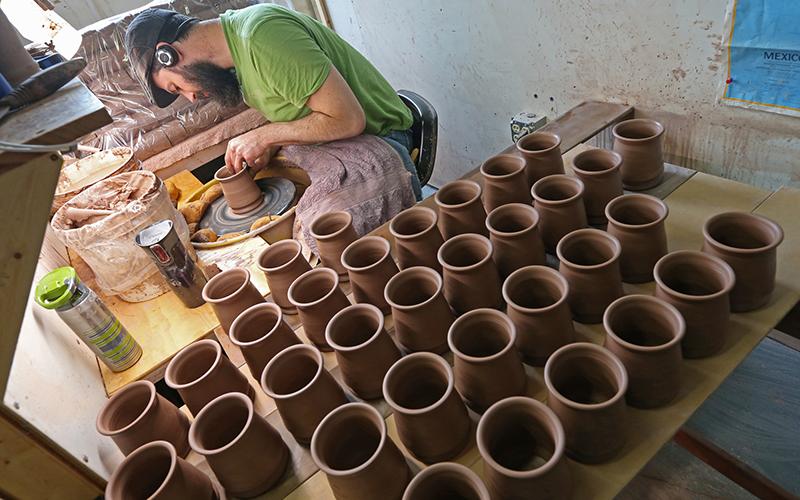
1. What is Pottery?
Before we dive into the history of pottery, let’s actually define what pottery is and how it’s made.
Pottery is made up of ceramic materials and encompasses major types of pottery wares such as earthenware, stoneware and porcelain. To be considered pottery, a piece must be a fired ceramic ware that contains clay when formed.
To create a piece of pottery, the potter must form a ceramic/clay body into a specific object, whether by hand built or wheel thrown techniques, and then heat it at a high temperature in a kiln to remove water from the clay. This allows for changes in the molded object, increasing its strength and durability while permanently setting its shape.
The potter can decorate the clay body either before or after firing, however, some processes require the clay go through certain preparations in order to successfully create a piece of work. With kneading, a process which involves massaging the clay with your hands, it allows moisture within the clay to spread throughout the entire slab. When done correctly the clay will have even moisture content and you’re one step away from creating.
The next preparatory procedure when working with clay is called de-airing. This is accomplished either by a vacuum machine that is attached to a pugmill or manually through the process of wedging. When the clay has been de-aired and de-moisturized, it’s ready to be shaped in a variety of ways. Once it’s shaped, it’s dried and then fired.
2. What do you think it is about making pottery that resonates with people so much?
Pottery has been around since the ancient people roamed the earth. As one of the oldest human inventions, the practice of pottery has developed alongside civilization. The earliest ceramic objects have been dated as far back as 29,000 BC. One of the most popular pieces dated from this time period is The Venus of Dolni Vestonice, discovered in the Czech Republic, a ceramic Venus figurine of a nude female.
Since clay is found nearly everywhere, early humans had easy access to this responsive material, allowing them to mold and shape the world they observed around them. With limited access to tools, clay also let these people mold and shape by hand, creating human statuettes, bowls, utensils and more.
As soon as early humans developed fire, they discovered that heating these formed clay objects transformed them into a different material that was permanent and much more useful to them — mainly items like bowls, plates, and utensils for storing and preparing food.
As civilization made more advances, pottery has always advanced right alongside it, even assisting by helping people survive and providing them with a higher standard of living.
For example, about 21,000 years ago, people located in East Asia were hit with an exceptionally cold climate over a lengthy period of time. To survive, these ancient people had to obtain the maximum calorific and nutritional value from their food. Pottery was the solution. By creating pots, they could then cook their food and improve nutrient intake from starchy plants and meat, the common foods located in the area.
Because of its many utilitarian uses, pottery has been revered throughout history. Of course, over the centuries, it has developed into so much more than just functional ceramic items.
3. When was pottery production revolutionized?
Sometime between 6,000 and 4,000 BC, the first potter’s wheel was invented in Mesopotamia. This brought about a revolution in the way ancient people could create items out of clay. No longer were pottery makers restricted to the long process of hand molding clay — they were then able to have more freedom in experimenting with new forms and aesthetics.
While pottery had always had intrinsic artistic qualities, when the potter’s wheel arrived, it was a game changer! Instead of serving primarily utilitarian purposes, it branched out and shifted to embrace artistic expression. While the earliest types of items found by archaeologists were generally undecorated, unglazed, hand-formed clay vessels, by 6000 BC, places like the Middle East, China and Europe had developed a wide array of design techniques.
From intricate painted designs that told the history of a Pharaoh’s reign to highly polished bowls and plates to elaborate animal figures, ceramists attained remarkable skill and ability that was never seen before, thanks to the invention of the potter’s wheel.
4. How did potters wheels turn before electricity?
The first mechanical potter’s wheel wasn’t invented until the 19th century, so the first manual potter’s wheel was truly a lasting innovation.
There are many ways to operate a potters wheel without electricity. For the most part, in ancient times, pottery wheels were turned manually, with the user kicking their feet to put it in motion. Other ways to spin a potters wheel included using a stick that is put in a hole at the top of the wheel and then turning it, or simply speeding it up by hand.
Once the mechanical wheel was invented, potters could start manufacturing multiple items per hour, completely revolutionizing the industry once again!
5. How has the making of pottery changed in the past 100 years?
Pottery has changed a lot since the early days of hand-formed ceramic bowls and manual wheels. The biggest change within the past 100 years involves the kiln, another required tool of the pottery trade. Since potter’s wheels have been electrified, so too have kilns moved from gas to electric. Even in the past 20 years, innovators have made progress in the kiln industry, developing electronic programmers to control the temperature and power of the kiln.
When it comes to industrial production, fired ceramic ware has moved from jiggering to pressing. Jiggering is the mechanical adaptation of wheel throwing and is used where mass production or duplication of the same shape, like bowls and plates, is required. Pressing, on the other hand, involves setting a ceramic slab against a mold plate to achieve a customized look.
And some of the biggest innovators in today’s pottery industry have taken a technologically focused approach. Most production lines at major manufacturing facilities have been automated to reduce human power while increasing machine automation.
6. What do you think the greatest advantage is to producing pottery?
Pottery is one of the most durable forms of art, with many fragments found from almost all time periods and civilizations throughout the world. There’s no doubt that ceramic items last much longer than other artifacts that were crafted from less-durable materials. When a person makes a piece of pottery, they’re likely to consider it’s lasting quality and what it means to have something made by their hands be found millenniums later — it’s something that piques the interest of many who learn the practice.
Within the studios of Deneen Pottery, many resident potters say this is the reason they got into the work in the first place. When asked about the longevity of this unique medium, Texas Teena, art director of Deneen Pottery responded, “I think of that often, especially when I design a ceramic mug that has a historic building on it. There could come a time when the only our mug is the only remaining reproduction of that building.”
7. What is the most exciting thing that has happened to pottery within the last five years?
Thanks to the intersection of pottery customization, marketing and affordability, more and more people are snatching up custom-design items, like branded coffee mugs. From corporations and nonprofits to museums and monuments, even events; everyone wants to take advantage of the many benefits a custom-designed mug offers, making it a hot-selling item for pottery companies around the world.
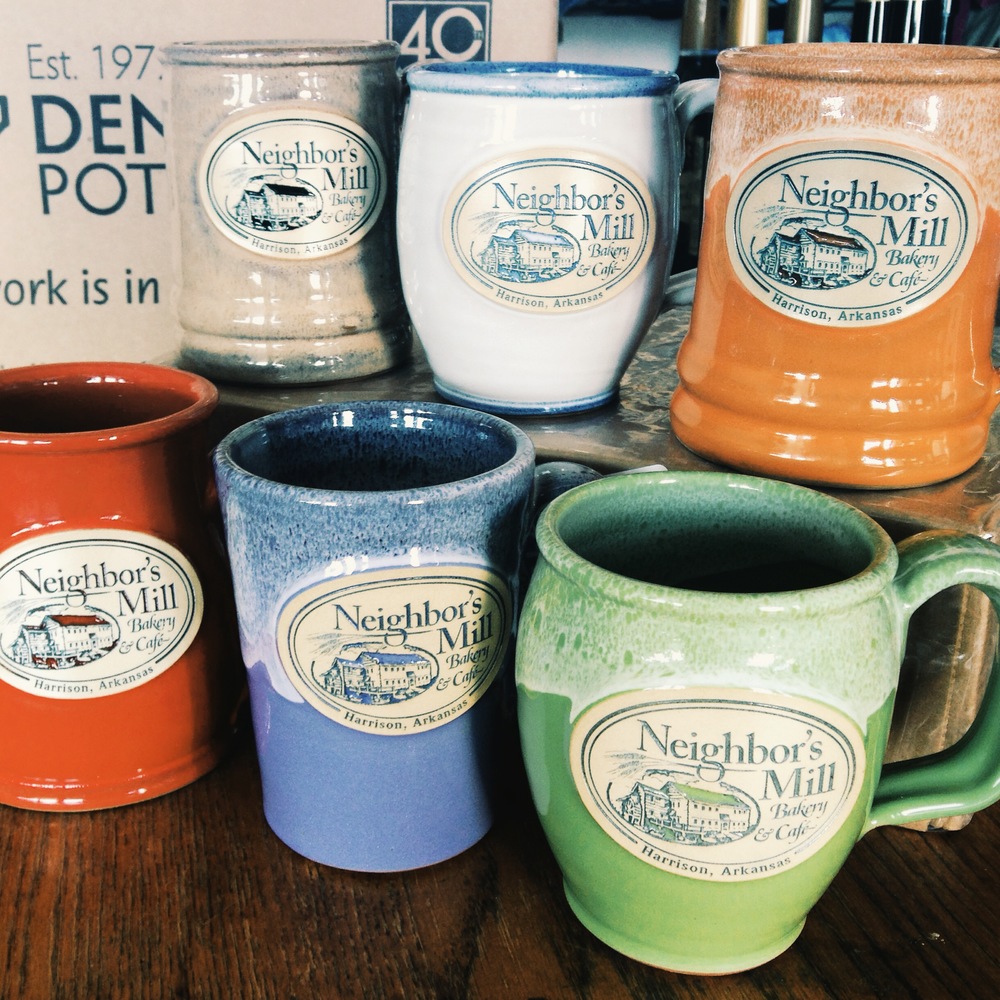
8. What does the future of pottery have in store?
Throughout the development of civilization, people have relied on pottery to improve their way of life. That shouldn’t change all that much in the near future. People will always have the same need for pottery that they’ve always had, whether it’s for utility or artistic functions. From a potters perspective, the need for pottery won’t be satisfied by manufacturers based in the U.S. Because of steep competition from low-cost imports, many domestic manufacturers are either outsourcing their manufacturing facilities to decrease costs or shutting down.
As for Deneen Pottery, we believe that we have a bright future and confident outlook because our product is more than a simple utilitarian piece. Our work carries aspects of fine art depicting hallmarks of places and events that people want to carry home with them to commemorate a special memory in their life. We’re committed to preserving our customer’s memories for years, centuries, even millenniums (OK, maybe just a few fragments for that last one) to come.
Looking for custom handmade in the U.S. logo mugs for your business?
How to Get Started
Creating Pottery
Making pottery for beginners can be an enjoyable, therapeutic and relatively easy hobby to pick up. Almost anyone can grow their skills as a potter with the right tools, techniques and inspiration.
Just because you’re a beginner, you should never be afraid to get started creating gorgeous, hand-thrown or hand-built pottery. If you’re trying to learn the art, we’ve developed this guide for you. So let’s get started – here’s the ultimate guide on how to get started with pottery!

Pottery for Beginners: Main Techniques of Making Pottery
There are two main methods of making pottery: hand built and wheel thrown as seen above in the “Image courtesy of Lakeside Pottery Studio” in Rehoboth, DE. The easiest to start with with is the hand building method, since you just need your hands and a piece of clay. There are three main techniques involved in making hand building pottery:
- Pinch pot – a simple form of hand-made pottery that’s been around since ancient times. The potter kneads the clay and presses it into the shape of a pot, dish, bowl or cup.
- Coiling – using clay, the potter rolls it until it forms a long roll. Then, by placing one coil on top of another, different shapes are formed.
- Slab – a thick, flat plate, or slice of clay is cut into shapes which are then joined to form an object. The joined edges are scored and slip is used (slip is clay diluted with water to the consistency of cream, used for joining individual pieces of clay).
Wheel-thrown pottery, however, requires special knowledge about how to work the wheel and handle the clay while it’s spinning, among other things. Pottery wheels are used to mold clay into many different shapes. It takes time to become skilled with wheel-throwing, but it’s a much more efficient method once mastered. Pottery wheels can be powered by electricity or manually by the potter kicking their leg.
Pottery for Beginners: Types of Clay Pottery
Now that you know the two main techniques to creating pottery, let’s take a look at the materials you’ll need. First, and most importantly, is the type of clay used. Broadly speaking clay can be classified as earthenware, stoneware or porcelain.
Earthenware is made of baked clay, and often finished in a glaze. Because it’s a porous material, earthenware pottery can crack when exposed to water or heated, such as in the dishwasher.
Stoneware (which is what we use) is one of the most popular clay materials to make tableware with because of its imperviousness to liquid and heat. While it’s hard like porcelain, it’s opaque like earthenware and available in colors from white to tan, red and speckled. The exact composition of stoneware clay can also vary greatly and depending on the region or recipe you’re following the consistency can range from smooth (few impurities) to rough (many additives). Feel the bottom of any pot and you’ll see what we’re talking about. Each mug we make is silky smooth which means we’re using the purest select clay that we can find.
Porcelain pottery closely resembles glass and does best with a dialed in firing process that makes sure that the required firing temperatures were reached. We would not advise starting with this material. It would be better to hone your skills on either earthenware or stoneware before moving up to porcelain.
Pottery for Beginners: Main Equipment Needed
Beginning potters should know the different techniques and materials used for creating pottery, as well as the relevant, required pottery equipment to achieve various forms.
Kiln 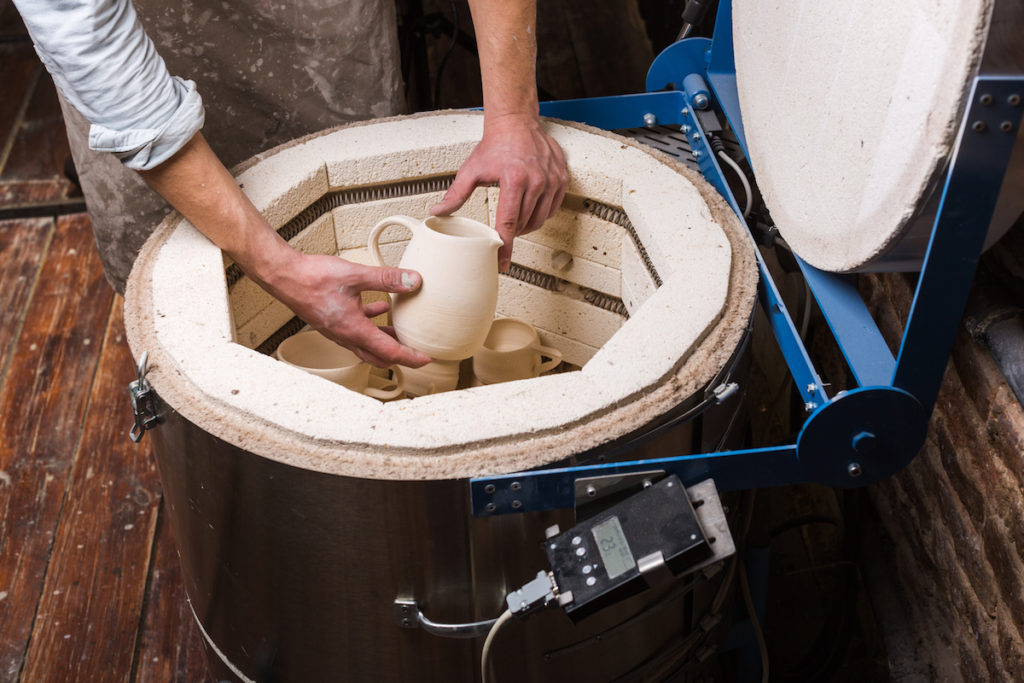
The main piece of equipment you’ll need to get your pottery hobby off the ground is a kiln – a simple device for firing and baking glazes onto the pottery. The primary reason that you will want a kiln is to chemically transform the clay into a permanent lasting relic. While not necessary for smaller pieces that won’t come into contact with water, a kiln is necessary for creating pieces that you will want to use, like tableware, cups or vases.
Professional potters usually use a mix of firing processes and kilns that include: commercial-grade wood, gas kilns, and electric. As a beginner, you’ll most likely stick to an electric-powered “hobby” kiln that reaches a maximum temperature of about 2340°F which should have easy to use temperature controls and an easy to use guide.
Small kilns simply plug into a standard wall outlet, while larger kilns may need to be hooked up by a professional electrician and would require a dedicated service. In terms of cost, you can expect to pay a few hundred dollars for a compact or used model, and up to a few thousand dollars for a larger kiln.
Skutt Kilns are a great option for beginners as they have a wide range of sizes that all provide a high quality fire. A good choice for a new potter is a kiln called the Skutt 714. This kiln that has all of the features of a larger kin, with a more compact size. The capacity of this kiln is 14″x14″ and it weighs less than 100 pounds, making it compact enough for a home studio. Learn more about this kiln, and view other sizes here
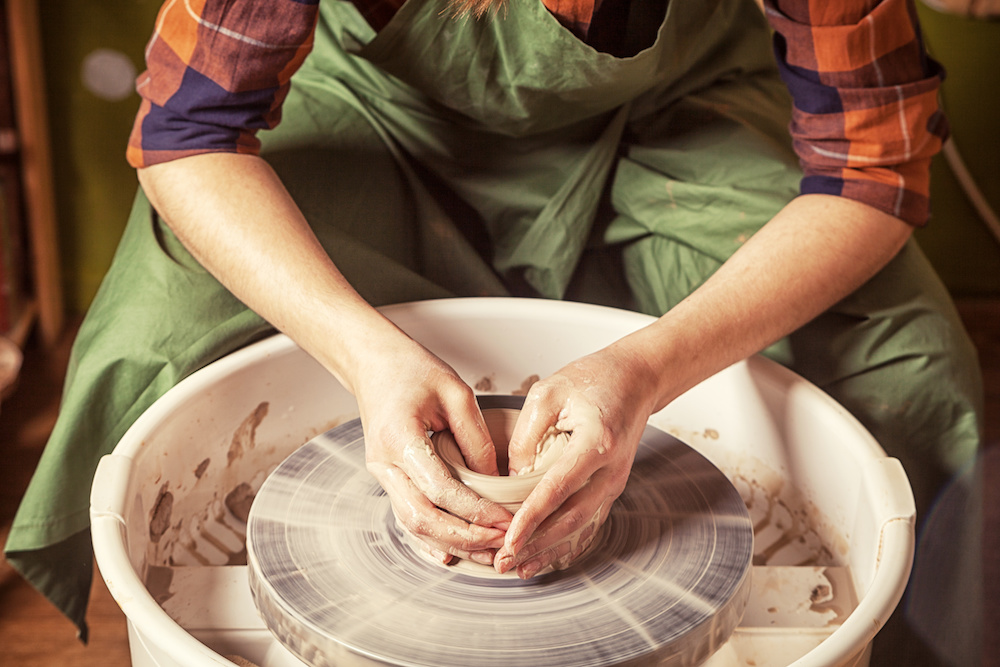
Pottery Wheel
If you’re interested in making more advanced ceramic pieces, you’ll need to invest in a potter’s wheel. These wheels come in both electrical-powered and manual-powered styles, both offering different advantages and disadvantages.
For a beginner, producing pottery on a small electric wheel is a good choice because it doesn’t require the user to develop the coordination needed to kick the wheel while forming a shape. These also provide more torque and speed control to help manage the clay. In our studio we utilize Brent wheels and they are fantastic for both a beginner up to a master production potter. Parts are easy enough to change out and we can verify that one wheel can easily create over 500,000 mugs before any repair will be needed.
Manually operated wheels, on the other hand, can give the user more control than an electrically powered wheel. This is because the potter has complete control of the wheel speed by how much they kick the wheel with their foot.
Pottery Modeling Stand
If you’re sticking with the hand building method of making pottery, a pottery molding stand will come in handy. While not a required piece of equipment, it does make the creation process easier. The potter simply places their slab of clay on this raised, fully rotational surface area, making it simple to form.
Pottery for Beginners: Main Tools Used
While the above equipment is crucial, you’ll also need a variety of special tools to craft the piece of pottery you’re envisioning. There aren’t too many needed right away – in fact, your hands are the main tools you’ll use throughout the entire process. However, there are a few items that can make the process easier, more efficient while helping you expand your abilities.
Pottery Tools for Beginners 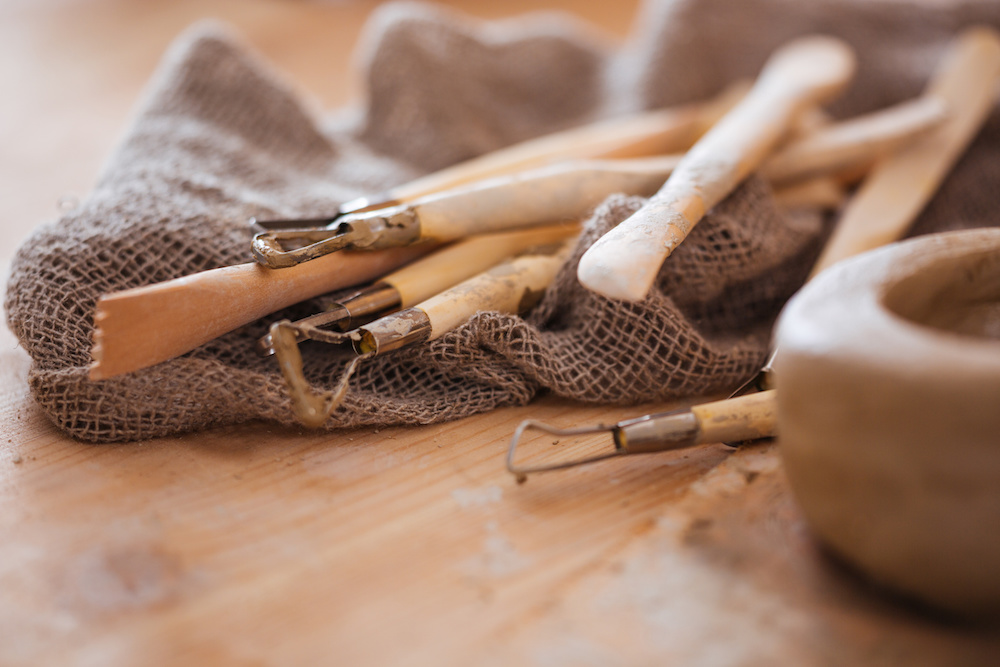
- Apron and towels – pottery is a very messy form of art. Don’t wreck your clothes and keep your hands clean with an apron and towels.
- Sponges – these versatile tools are incredibly useful when working at the potter’s wheel. Sponges help absorb or distribute water during throwing, making it easier to mold and shape the clay. A sponge attached to an extender can help remove or distribute water to and from hard to reach areas.
- Wire – you’ll need a thin piece of wire in order to remove the piece of pottery from the wheel once it’s complete. The wire is usually nylon or metal with wooden notches at each end which the user holds.
- Ribs and scrapers – these handy tools help shape and smooth pottery as it’s being formed on the wheel. They can also be used during the rib-and-hand technique used on coiled pottery.
- Potter’s needles – these specialized pottery tools resemble long needles and are perfect for a variety of different uses, such as trimming edges on a wheel or scoring slabs of clay for hand throwing applications.
- Fettling knives – available in soft or hard temper, these knives can be used to achieve desired angled and curved cuts. Soft fettling knives are flexible and can be bent into a variety of shapes, while hard fettling knives are more inflexible and are better for making clean, straight cuts.
- Chamois leather – these tools are great for smoothing the rim of pots or compressing edges of thrown ware.
- Loop, wire and ribbon tools – a set of these will give you versatility when trimming slabs of clay, especially when hand molding pottery.
- Brushes – great for when trying to carry water and slip to specific areas when you’re molding clay. You will also need brushes to apply any paint, underglaze or overglaze.
- Throwing stick – this tool assists in cleaning up the outside of pottery pieces, as well as making an undercut bevel at the base. A bevel makes cutting the pot from the wheel much simpler.
- Wooden ribs – use a wooden rib to smooth the base of your pottery, especially shallow bowls or plates.
- Potter’s Calipers – calipers are used to measure the inner and outer dimensions of pots where they will meet with other parts of a working set.
- Wooden modeling tools – wooden modeling tools come in an astounding variety of shapes, and are useful for various hand-throwing applications.
Pottery for Beginners: Understanding Glazes
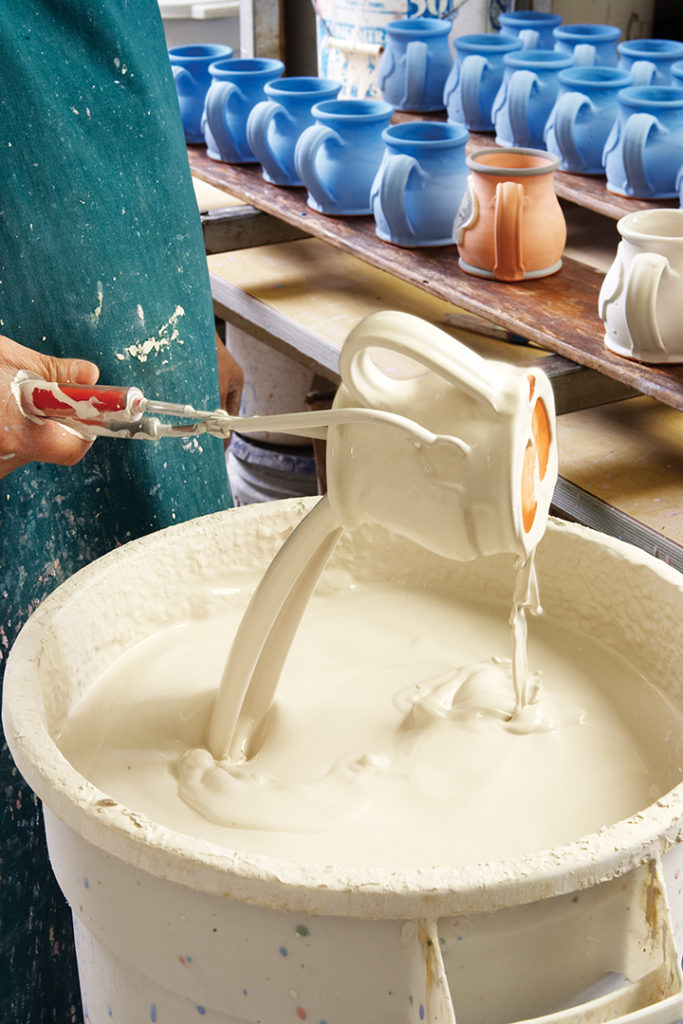
Pottery glaze doesn’t just give the piece a better-looking aesthetic, it also seals the pottery, protecting it from damaging water and heat. After the pottery goes through its initial firing stage to dry the piece, glaze is applied and placed into the kiln again for a second firing. The glaze material melts and sticks to the pottery, providing protection, waterproofing and enhanced aesthetic to the piece.
Glazes normally come in three types of finish, matte, opaque and gloss. In general, gloss finish is used for pottery like tableware, as it’s shiny, easy to clean and non-porous. Matte, offering no shine, is generally used to create a more subdued, sophisticated look. Opaque simply describes a glaze that can’t be seen through, thus covering the surface and color of the clay. Of course, not all pottery requires a glaze flowerpots, for instance, may be crafted without being glazed.
There are also sub-categories of these different glazes, such as semi-transparent, semi-gloss and semi-opaque, among others. You’ll have to test a few to find out which style you prefer.
Glazes come in literally thousands of combinations of colors, textures, styles and types that can be applied in many different ways and fired at a range of temperatures. Some glazes may be vividly colored but still have aspects of the clay showing beneath. For example, you can use a speckled clay and a transparent glaze which can create an interesting and unique look.
We’ve found that what works best is keeping the kiln firing cycle consistent so that you can play with different glaze recipes. Today we have over 170 different glaze combinations from 39 individual solid glazes from our base recipe that was invented in back in 1972. Each color is formulated and mixed from scratch and had a high gloss shine.
We would recommend starting out with pre-made glazes that are designed to give you consistent results with a variety of different firing temperatures, methods and types of clay. Continental Clay on Stinson in Minneapolis is a terrific resource! There are also many options to make a glaze yourself by buying powder from a ceramics supplier or your local art store. When purchasing your first glaze, it’s important to read the temperature rating – the firing temperature must match that of your clay and be within the limits of your kiln.
Everyone can take-up this enjoyable hobby – so what are you waiting for? Now that you know how to get started making pottery, you can give it a try yourself! Just because you’re new to the art doesn’t mean you can’t create gorgeous, functional pieces of pottery. All you need is the right knowledge, tools and inspiration to help. Best of luck with your first piece of pottery!
Looking for custom handmade in the U.S. logo mugs for your business?
Pottery is one of the oldest and most widespread of the decorative arts. As such, there is plenty to learn about the art form and the practice of creating gorgeous, functional pottery.
Deneen Pottery has developed this guide to inform you about all of the different types of pottery. Let’s get started!
Types of Pottery
There are three commonly accepted types of pottery, including earthenware, porcelain and stoneware.
Earthenware Pottery
Earthenware is normally fired at a lower temperature than the other two categories, made of clay dug from the ground. If not glazed, it will absorb water and will not allow light to pass through it. The color of the pottery will depend on the clay you use, usually a buff, brown or reddish hue.
Because of its natural water-absorbing qualities, the fired object is covered with finely ground glass powder suspended in water and is then fired a second time. During the firing, the fine particles covering the surface fuse into a protective, glasslike layer, known as the clay body and make the piece waterproof.
A modern earthenware recipe may consist of: 25% ball clay, 25% china clay, 35% flint, 15% china stone. The first or biscuit firing temperature is 1100° – 1150°C and the second, glost (glaze) firing is 1050° – 1100°C.
Traditionally, earthenware pottery is the most commonly found type of pottery among ancient, medieval, Middle Eastern and European cultures, and is still one of the most popular types today.
Porcelain Pottery
Porcelain pottery is made from a mixture of materials, generally china clay (kaolin) and china stone (petuntse).
There are three types of porcelain:
- Hard-paste – a ceramic material that was originally made from a compound of the feldspathic rock petuntse and kaolin fired at very high temperature, usually around 1400°C.
- Soft-paste – produced by mixing white clay with ‘frit’ – a glassy substance that was a mixture of white sand, gypsum, soda, salt, alum and nitre. Lime and chalk are used to fuse the white clay and the frit, the mixture is then fired at a lower temperature than hard-paste porcelain.
- Bone china – a type of soft-paste porcelain that is composed of bone ash, feldspathic material, and kaolin. Bone china has a translucent body containing a minimum of 30% of phosphate derived from animal bone and calculated calcium phosphate.
Porcelain pottery came to prominence in China; the reason why it’s commonly referred to as “china”. Porcelain is a vitrified pottery with a white, fine-grained body that is usually translucent, as distinguished from earthenware, which is porous, opaque and coarser.
In the East, porcelain is defined as pottery that is resonant when struck; in the West, it is a material that is translucent when held to the light. Neither definition can encompass every piece of porcelain, as some heavily potted porcelains are opaque, while some thinly potted stonewares are somewhat translucent.
Stoneware Pottery
Stoneware pottery is made of clay, but is fired at a higher temperature than earthenware. The temperature is high enough to partially vitrify the materials and make the ware impervious to liquids even when unglazed. Because stoneware doesn’t absorb water, it doesn’t require the potter to apply a glaze – glazes are purely for aesthetic purposes.
Dark colored stoneware is made from buff, brown and red clays without any added ingredients. The majority of current glazed stonewares are salt glazed.
A modern stoneware recipe may consist of: 25% ball clay, 25% china clay, 35% flint, 15% china stone. Firing: 1200° – 1300°C. There is usually only one firing, but if a glost firing is required it will be at about 1050°C.
Stoneware was made by the Chinese in antiquity and became known in northern Europe after the Renaissance (14th century to 17th century).
Pottery Classifications
Beyond these three main types of pottery, there are also various pottery classifications among the main forms of pottery. These include forms such as creamware and bisque, among others, including:
Agateware Pottery
Agateware pottery is made by mixing different-colored clays or by mixing different slip colors. Clays are laid out in slabs, on top of each other, and then beaten out to form a single mass in which the colors are indistinguishably combined.
Basalt Ware Pottery
Sometimes called Black Basalt, this type of pottery is a hard black vitreous stoneware, named after the volcanic rock basalt and developed by English potter Josiah Wedgwood in the late 16th century.
Bisque Pottery
‘Bisque’ or ‘biscuit’ porcelain is simply the once-fired body without the addition of glaze. Since it is only fired once, it has no chemically bonded water left in the clay. Bisque is a true ceramic material, and has a natural, “unfinished” aesthetic to it.
Cauliflower Pottery
Cauliflower pottery is made from creamware that has been modeled and glazed in green and yellow to simulate the look of a cauliflower. This classification also covers other fruit or vegetable forms of pottery.
Creamware Pottery
This popular form of pottery encompasses cream-colored English earthenware, which was prominent in the second half of the 18th century. Staffordshire potters were experimenting in order to find a substitute for Chinese porcelain, and in the year 1750, produced a fine white earthenware with a rich yellowish glaze. Light in body with a clean glaze, it proved ideal for domestic ware because of its sharp look and more affordable pricing.
Delft Pottery
Delft pottery is a blue and white, tin-glazed earthenware first made in Delft, Holland, in the early 17th century and subsequently produced in Holland and England. Delftware includes pottery objects of all descriptions such as plates, ornaments and tiles.
Flambe Pottery
Flambe pottery consists of a distinctive glaze. The glaze is a rich, deep-red slashed with streaks of purple and turquoise and is used to decorate pottery, particularly porcelain.
Jasperware Pottery
Introduced by Josiah Wedgwood, Jasperware is a type of fine-grained, unglazed stoneware. Developed in 1775, it came from a long series of experiments aimed at discovering the manufacturing techniques of porcelain. Its name derives from the fact that it resembles the natural stone jasper in its final form.
Majolica Pottery
Majolica is a general term for pottery glazed with an opaque tin enamel that completely covers the hue of the clay body. It has been made since the fourteenth century.
Marbled Pottery
Marbled pottery is made by mixing various colors of clay to imitate natural marble or agate material. This form of pottery has been around since at least the 1st century AD, and artifacts have been recovered all the way from Rome to China.
Pate-sur-Pate Pottery
Literally translated to “paste on paste”, this laborious process involves building up a piece of pottery with layers of liquid slip, each one having to dry before the next is applied until a relief decoration is formed.
Pearlware Pottery
Pearlware pottery is perhaps Josiah Wedgwood’s greatest contribution to European ceramics. This form of pottery features extremely pale creamwares with a bluish tint to its glaze.
Redware Pottery
This one is pretty straightforward – as the name suggests, redware pottery refers to reddish-colored earthenwares, normally finished without a glaze.
Salt Glaze Pottery
Salt glaze typically applies to ceramic pottery types. Salt glaze is formed on stoneware by throwing common salt into the kiln at its hottest temperature to create a textured effect. Sodium from the salt combines with silica in the clay to form a glassy coating of sodium silicate.
Slipware Pottery
This type of pottery was the main decorative style in the 17th and 18th centuries before enamels became widely available. Earthenware pottery is decorated with colored slip and then glazed.
Spatterware Pottery
Sometimes called spongeware, spatterware pottery refers to a broad category of pottery that is decorated with colors that look as if they were spattered or sponged onto the piece.
Tortoise Shell Pottery
Tortoise shell pottery is a decorative technique applied to earthenware, providing the final piece with a unique textured effect.
Transferware Pottery
Transfer printing is a process by which a pattern or design is etched onto a copper (or other metal) plate. The plate is then inked and the pattern is “transferred” to a special tissue. The inked tissue is then laid onto the already bisque fired ceramic item, glazed, and fired again.
Initially, patterns were transferred to the ceramic items after glazing, but the ink often wore off, thus “underprinting” was born. Transfer items have a crisp, almost decal look about them. If you look closely you can often see the place where the transfer design ends. Often these are the areas where the pattern doesn’t quite match, like wallpaper.
Now that you know about all the different types of pottery, you can get out there and give it a go with your desired form. Best of luck with your efforts!
Looking for custom handmade in the U.S. logo mugs for your business?
Pottery Inspiration
For Decor
Pottery decor, whether it’s a family heirloom or a fortuitous find, provides a space with visual intrigue that adds substance and soul to your overall home design.
For generations, pottery has served both functional and aesthetic purposes, and not much has changed in the modern world of today. From prehistoric food storage vessels to tiles on space shuttles to decorative flower pots in your bedroom, pottery plays a crucial role in a variety of ways.

In general, the artistic role of pottery within the facet of home decor is growing. In all shapes and sizes, pottery is the perfect antidote to homogeneous decor. Whether displayed sparingly across a mantelpiece or a main component of a room’s decor, pottery has staked its claim as a unique design accessory.
In this section of The Ultimate Guide to Pottery, we’re exploring inspirational ways to utilize pottery within your home decor. Let’s get started!
Best Practices: Ways to Display Your Pottery
First, let’s get some basics out of the way. Below are best practices on how to display your pottery for maximum effect.
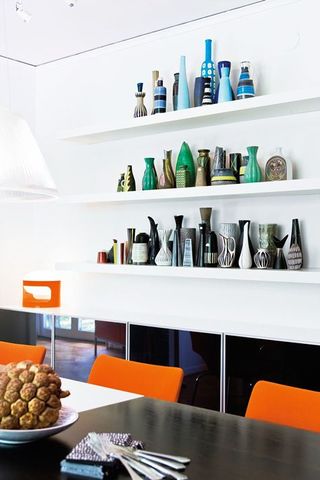 Group pottery pieces by color. Even if you’re going for a minimal, slimmed-down color scheme, you can still work pottery into your home’s decor. In fact, pottery can provide a splash of color to add even more visual intrigue. When decorating your home with pottery, group pieces together by color in a primary location to minimize the “cluttered” feeling and promote a more intentional arrangement. Putting colored vessels against a neutral backdrop, or neutral vessels against a colored backdrop will make your interior design stand out more, elevating the grouping to an art piece that can be moved and changed at will.
Group pottery pieces by color. Even if you’re going for a minimal, slimmed-down color scheme, you can still work pottery into your home’s decor. In fact, pottery can provide a splash of color to add even more visual intrigue. When decorating your home with pottery, group pieces together by color in a primary location to minimize the “cluttered” feeling and promote a more intentional arrangement. Putting colored vessels against a neutral backdrop, or neutral vessels against a colored backdrop will make your interior design stand out more, elevating the grouping to an art piece that can be moved and changed at will.
However, you shouldn’t be concerned with quantity over quality. To make a statement, you can have one gorgeous piece as the focal point of the room, complementing the color scheme to attract the eye toward the piece. Additionally, you can display several pieces from the same color family to draw-in attention.
Arrange pottery pieces artfully. Give smaller pottery pieces an anchor by including them in groupings with larger pieces. While it takes a good eye to properly mix shapes, experimentation is key. By keeping your groupings tight and placed purposefully toward one side of a surface — whether it’s a mantle, built-in bookcase or credenza — you create a space in your room that feels curated over time rather than purchased all at once just to fill out the area. 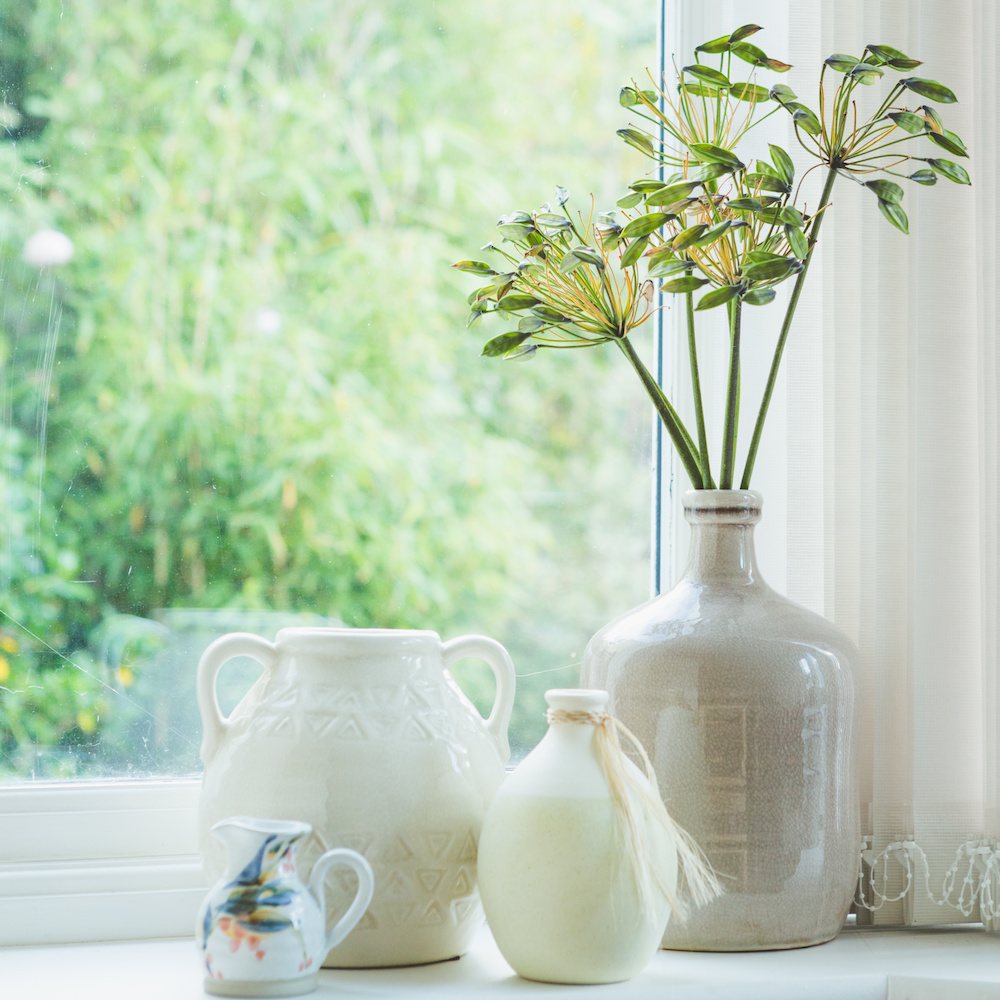
Placing taller items toward the back and pieces with more volume in the center will provide the foundation for your display. Medium-sized pottery can be added to build support, with the smallest pieces filling the gaps and rounding out the display.
Promote an organic style with plants. One of the easiest ways to achieve an organic look and inject some color into your decor is to add plants to your pottery. Try adding flowers, houseplants and herbs in beautifully glazed pots that accent your overall interior design.
Choose pots that support the beauty of the plant rather than take away from it. They should also be wide and deep enough to allow the plant to grow properly. Speckled or dual glazes in soft tones, for example, are perfect for enhancing the look of a plant and pottery display without sacrificing other design elements in the room.
Know the different types of pottery.From pottery to ceramics to porcelain, there are many various types of pottery. Pottery is generally considered to be any container made of clay. Ceramics are made from clay and glaze that are permanently changed when heated. Porcelain is a strong, vitreous, translucent ceramic material that is bisque-fired at a low temperature, then glazed and fired again at a very high temperature.
To find out more about the different types of pottery, check out the section in our Ultimate Guide to Pottery: The Different Types of Pottery
Fit Pottery within the Overall Home Style You Want to Achieve
Everyone’s home style is different. However, that doesn’t mean you can’t incorporate pottery into your home decor, whether you’re going for a midcentury modern, rustic farmhouse, contemporary style or anything in between.
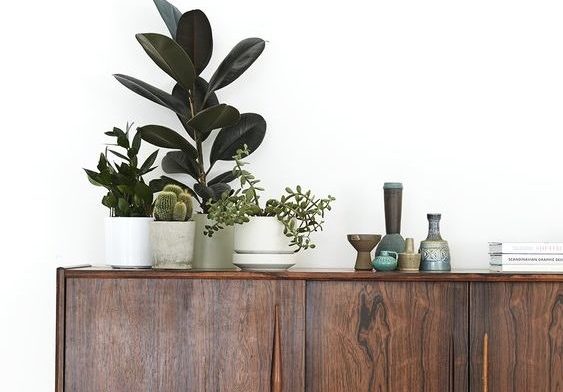
Midcentury modern style. This Scandinavian-inspired style has remained a popular choice for interior design enthusiasts since the 1950s. With its soft lines, uncomplicated textiles, low-profile furnishings and simple materials, midcentury modern is an attractive and attention-grabbing way to decorate your home’s interior. This style also accommodates pottery as a huge part of the overall decor. Bright colors, interesting shapes and an almost endless array of styles allow for simple updates when it comes to implementing the perfect piece of pottery for this clean, popular aesthetic.
Rustic farmhouse style. For those DIY interior decorators that love a rustic farmhouse look, pottery is the perfect addition. The best pottery to support your rustic farmhouse design are hand-painted pieces. To make the most of pieces in vibrant shades, keep them together en masse. For any pieces that have an authentic, timeworn style, such as an antique hutch, hand-painted pottery provides the right counterpoint. Another way to make your pottery pieces stand out is to paint the back of the display case in a rich, complementary hue to showcase your pieces.
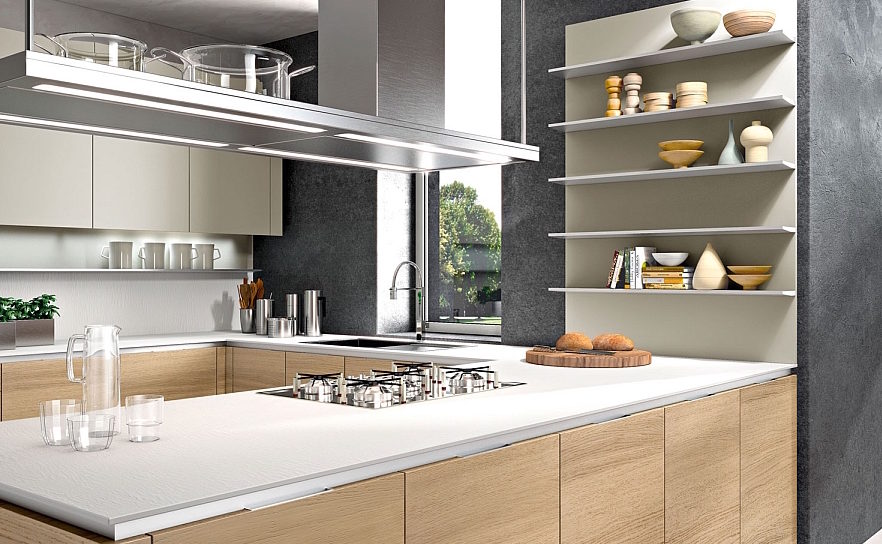
Contemporary style. When going for a contemporary style, pottery fits in well. With a well-pieced-together collection of pottery pieces, you can quickly warm up an otherwise empty space in a nontraditional way.

Vintage style. If vintage is the style you’re trying to achieve, soft linens, feminine furnishings and accessories that tell stories most likely form the basis of your interior design. Adding in a hefty dose of cream-colored pottery keeps the look in-lined with a vintage style. Don’t overdo it with large pieces; instead go for a variety of sizes and shapes to keep the pottery decor from falling to the wayside of other decor. If you want to add some formality, arrange your pottery behind glass doors but in plain view. Don’t forget to run a duster over your pieces and display case once a month to keep everything clean and tidy!
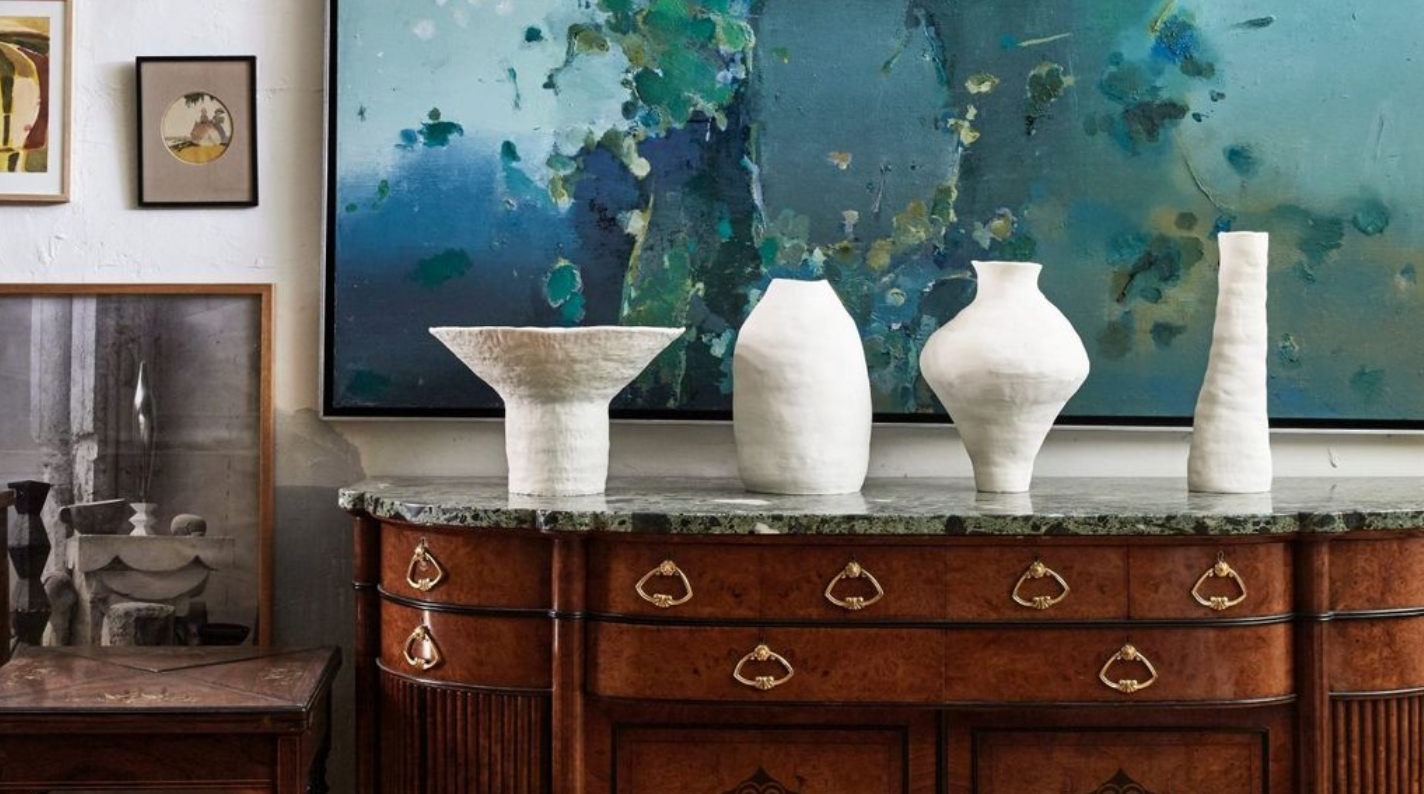
Eclectic style. For an eclectic look, try using a variety of pottery in an arresting display of shapes and colors against a monochromatic paint color — light or dark — to add a twist to your space. Balance the feel of the collection by ensuring the scale of the surrounding furnishings, lighting and art are larger than the pottery. To stop your display from veering into hoarder territory, keep it constrained to just one shelf or flat surface.
Pottery Inspiration for Decor in Conclusion
When trying to decorate your house with pottery, you can do whatever you wish. With a few simple tips and guidelines, however, you can transform your space into a visually appealing one. From antique urns to modern hand-thrown vases, it can keep your space from feeling sterile or impersonal. Whether you’re a minimalist who prefers a single piece or someone who prefers the look of a group of pottery pieces, there’s a something special out there ready to be integrated into your overall home design. Best of luck with your decorating efforts!
Looking for more information about pottery?
Check out the Deneen Pottery blog – where we post useful tips, how-tos, guides, checklists, tutorials and more.
About us – Deneen Pottery offers custom-branded coffee mugs for stores, shops, companies, corporations and all types of businesses. It’s our mission to collaborate with each of our customers to deliver the high-quality craftsmanship that’s kept us thriving for 45 years. If you want to learn more about Deneen Pottery or order handmade mugs for your company, contact our dedicated staff today.
Looking for custom handmade in the U.S. logo mugs for your business?
You know what they say: true beauty lies in the eye of the beholder. You don’t have to be a master artist to create something beautiful at the pottery wheel. It’s the potential inside of you that will shine through when crafting art from clay. When it comes to expressing yourself creatively through pottery, sometimes all you need is a little inspiration to get started.
In this section of The Ultimate Guide to Pottery, we’re taking a look at pottery inspiration for the artist inside you – here we go!
Inspirational Pottery Quotes
When it comes to making pottery, it helps to be inspired by others. Your creative process will greatly benefit and you’ll become a better artist overall. So, to kick off this chapter, we’ll start with some inspirational quotes that may motivate you to create your next special piece.
“Art is not what you see, but what you make others see.”- Edgar Degas
“For a potter to be able to make a pot that has life and vitality there has to be some brain power connected, some intellectual curiosity.” – Dwight Holland
“The aim of art is to represent not the outward appearance of things, but their inward significance.” – Aristotle
“Whether you succeed or not is irrelevant, there is no such thing. Making your unknown known is the important thing–and keeping the unknown always beyond you.” – Georgia O’Keeffe
“If I am a cup maker, I’m interested in making the best cup I possibly can. My effort goes into that cup, not what people think about it.” – Denzel Washington
“Art enables us to find ourselves and lose ourselves at the same time.” – Thomas Merton
“No man has the right to dictate what other men should perceive, create or produce, but all should be encouraged to reveal themselves, their perceptions and emotions, and to build confidence in the creative spirit.” – Ansel Adams
The mind loves the unknown. It loves images whose meaning is unknown, since the meaning of the mind itself is unknown.” – Rene Magritte
“We shape clay into a pot, but it is the emptiness inside that holds whatever we want.” – Tao Saying
“Every block of stone has a statue inside it and it is the task of the sculptor to discover it.” – Michelangelo
“The creative habit is like a drug. The particular obsession changes, but the excitement, the thrill of your creation lasts.” – Henry Moore
“The artist is a receptacle for emotions that come from all over the place: from the sky, from the earth, from a scrap of paper, from a passing shape, from a spider’s web.” – Pablo Picasso
“Every artist was first an amateur.”- Ralph Waldo Emerson
“The object of art is not to reproduce reality, but to create a reality of the same intensity.” – Alberto Giacometti
“The greater the artist, the greater the doubt. Perfect confidence is granted to the less talented as a consolation prize.” – Robert Hughes
“Don’t think about making art, just get it done. Let everyone else decide if it’s good or bad, whether they love it or hate it. While they are deciding, make even more art.” – Andy Warhol
“The arts are not a way to make a living. They are a very human way of making life more bearable. Practicing an art, no matter how well or badly, is a way to make your soul grow.” – Kurt Vonnegut Jr.
“Art is the only serious thing in the world. And the artist is the only person who is never serious.” – Oscar Wilde
“If I create from the heart, nearly everything works: if from the head, almost nothing.” – Marc Chagall
“Any form of art is a form of power; it has impact, it can affect change – it can not only move us, it makes us move.”- Ossie Davis
“I have always said that you do not see a thing until you look away from it. In other words, an object or a fact in nature has not become itself until it has been projected in the realm of the imagination. – Marsden Hartley
Never Run Out of Ideas: Tips on Generating Inspiration
We all have a bit of creative block every now and again – it even happens to the best potters in the world. To ensure that you never run out of ideas, follow the tips below and keep the inspiration flowing.
10 Tips to Fight Creative Block as a Potter
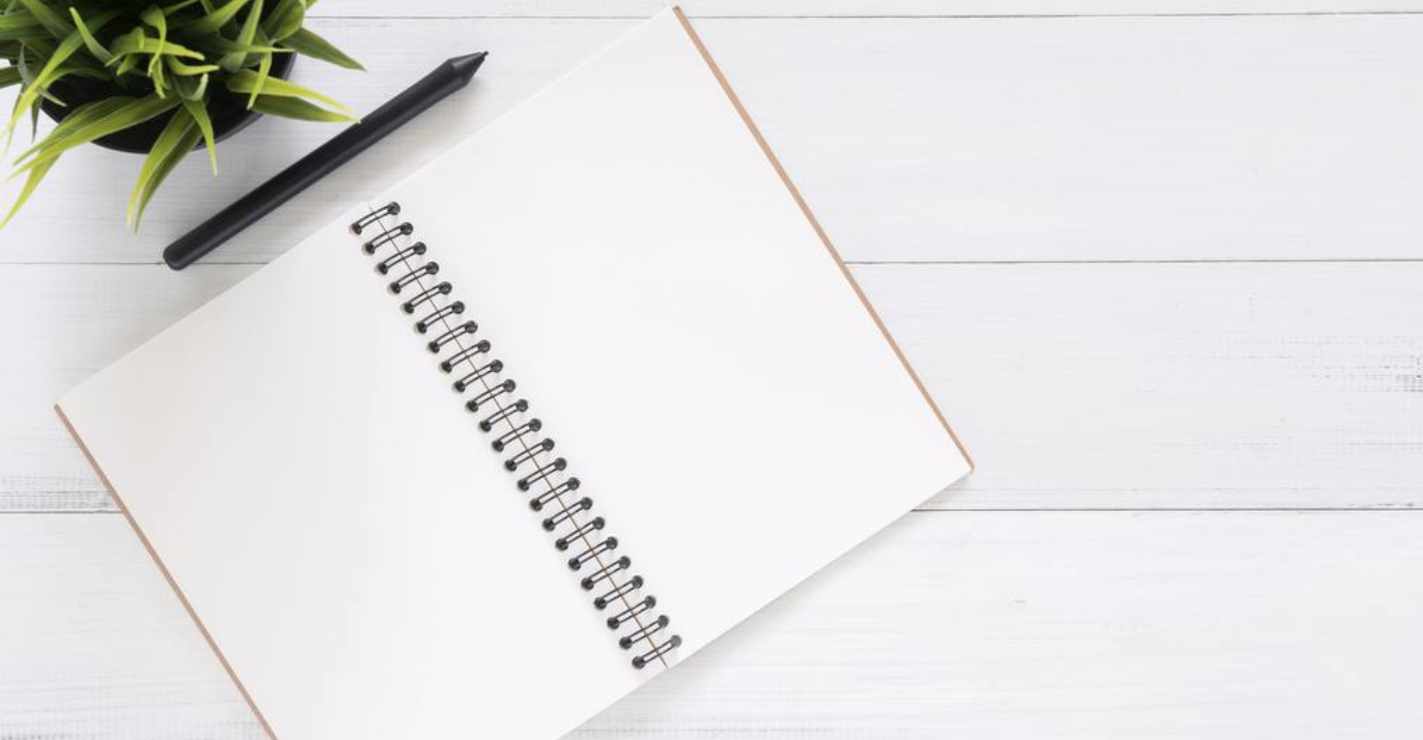
1) Keep a notebook or sketchbook on you at all times
This is crucial, as the best ideas can strike you at anytime and anywhere. Whenever something comes to mind, take down notes or sketch out an idea to save for later. In the future, whenever you face a creative block, just revisit your ideas and hash them out further.
2) Tear up your master plan
sometimes, just going with the flow, rather than planning out each aspect of your piece can lead to some interestingly creative ideas. Experiment with different material, glazes, tools, etc. This will help you to become a better potter overall.
3) Even if you can’t think of an idea, hit the potter’s wheel
Don’t wait around for inspiration to strike, instead, just start playing with clay, molding it into unique shapes. The forms you come up with could lead to bigger and better ideas that you can then move forward with
4) Revisit old pieces
Did that coil pot you made a few months ago not turn out as well as you expected? Did a recently thrown vase get burnt in the kiln? Take a few more stabs at it and perfect the process.
5) Upgrade your equipment
Perhaps a creative block isn’t the only thing holding you back. It could be that your equipment is malfunctioning, out-dated or just not good enough for your needs. Check out the latest pottery wheels, kilns, even materials and glazes to amplify your art and your process.
6) Practice makes perfect
Becoming a great potter doesn’t happen overnight. You may spend weeks, months or even years getting a certain technique or style down pat. But, never give up! Keep practicing, everyday, and soon you’ll reach your goals.
7) Inject some fun in your pottery studio
Nothing can stifle creativity like a bland environment. Always try to inject some color, energy and intrigue into your studio, whether it be painting the walls, hanging up inspirational quotes or your displaying favorite artworks. If you don’t want your surroundings negatively affecting you, don’t make it feel sterile.
8) Study other forms of art
Sometimes, you can find inspiration in other forms of art, whether it be a painting, poem or music number. You can even find inspiration in non-traditional forms of art, like interior design, architecture and fashion. Head to your local museum and check out their exhibits, take art classes at a community college, or just browse images online and a bright idea may just strike you.
9) Don’t be afraid to step away from your work
If you’re feeling overwhelmed or uninspired, it may not be the best time to make a piece of pottery. Try to distance yourself from the project; take a break and come back to it with a clear head. Sometimes, this is easiest solution to the creative block you’re facing.
10) Seek out what scares you most
Is there a certain technique or material that you’ve been afraid to try? Get as close to it as you possibly can. Fear can be an excellent motivator, and embracing those fears you have with pottery will help you get over a creative block. Jot down a list of the creative things you’re most afraid to try and then force yourself to give them a try.
Inspiration for Potters in Conclusion
When developing your next piece of pottery, remember: sometimes the greatest inspiration comes from within. All you need is the motivation to keep practicing, experimenting and creating to craft masterpieces at the potter’s wheel. Now that we’ve provided you with these quotes, ideas and tips to stay inspired, you can get started working on your next amazing piece of art – best of luck!



